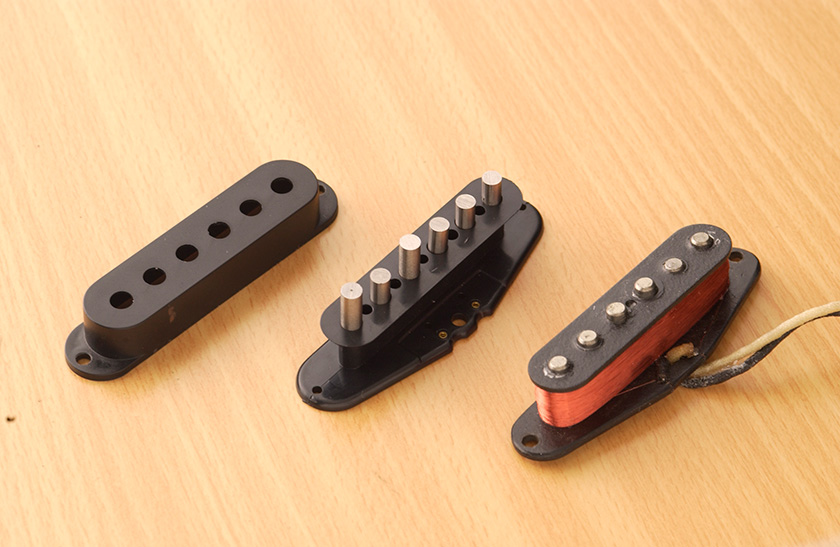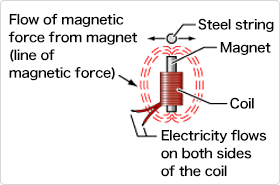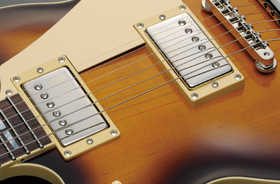The Structure of the Electric Guitar
What are pickups?
Inside a pickup is a magnet and coil
The pickup could be said to be the "heart" of an electric guitar. This device converts string vibrations into electricity, and is embedded in the body of the guitar right beneath the strings. Pickups use coils, which you may remember from conducting science experiments in school. An electric guitar pickup consists of a black bobbin with six magnetic bars inserted, and a material such as enameled wire wound around the magnets. Six magnets are used to better pick up the sound from the six stings. Some pickups use metal rods instead of magnets. In this case, a long and narrow magnet is laid under the bobbin.

Magnets are inserted into the bobbin, then wound with enamel wire. The enamel wire has a diameter of around 0.05 mm.
Why use a coil?
Coils are also found in telephones and hand held microphones. Coils and magnets can be used to convert sound to electricity, even without electrical power. This works because an electric current flows through the coil when a magnetic body is moved over the magnet and coil. In an electric guitar the steel strings act as magnetic bodies. A change occurs in the electric current depending on the frequency at which the strings vibrate. The frequency wave of the strings and the wave of the electric current tend to work together, and the pickup uses this property to convert the sound into electricity.

How pickups work
There is a secret to how the coil is wound
Although the way the coil works is quite simple, the sound will change depending on the number of times the coil is wound, or even the way it is wound.
Although winding the coil more will increase the volume of the sound, if wound too much the sound will become muffled. Even after winding the coil hundreds or thousands of times, the sound could still change if the coil is then wound even several tens of times.
Meanwhile, the issue with how the coil is wound concerns the size of the gap in subsequent windings after the first time around. These gaps are incredibly small: as little as 1/100th of a millimeter. Increasing the size of the gap improves the treble. It gets even more complicated-the winding height and even the surface area of the winding (when seen from above) will affect the sound.
Noise cancellation
Electric guitar pickups can include one or two coils. A pickup with one coil is called a "single coil pickup," while one with two coils is called a "humbucking pickup."
Although coils are susceptible to outside noise, the two coils in a humbucking pickup cancel out each other's noise (hum cancellation), helping to reduce noise. Conversely, single coil pickups do not perform any noise cancellation, but offer a crisp and clean high-pitched tone.

The silver parts are pickups. The photo depicts humbucking pickups, which feature two coils under metal covers.
How hum cancellation works

Outside noise (humming) depends on how the coil is wound (and how many times the coil is wound) so coils A and B are wound in opposite directions to cancel noise, then the magnetic pole orientation is reversed and the phase of the output is aligned.
Musical Instrument Guide:Electric Guitar Contents
Structure
How to Play
How the Instrument is Made
Choosing an Instrument
Care and Maintenance
Trivia
- Slide guitar playing may have been invented in a bar
- Feedback:Great for guitar playing! Not so great for karaoke...
- What is the difference between an electric guitar and electric acoustic guitar?
- Is there a way to eliminate the noise heard when plugged into an amplifier?
- Whole note down tuning for deeper bass
